Article by: Asst. Prof. Suwan Juntiwasarakij, Ph.D., Mega Tech Senior Editor
หากมองดูรอบตัว จะพบว่าเวลานั้นหมุนเร็วกว่าที่เคยเป็น ไม่เพียงแต่ความแตกต่างของลักษณะทางประชากรและภูมิศาสตร์การเมืองและประเด็นเกี่ยวกับความยั่งยืนของทรัพยากรในระยะยาวจะมีส่วนผลักดันให้เกิดการเปลี่ยนแปลงในทุกมุมโลกแต่เพียงเท่านั้น ความก้าวหน้าของเทคโนโลยีที่รวดเร็วเป็นเท่าทวีคูณก็ร่วมส่งผลกระทบสนั่นหวั่นไหวต่อโครงสร้างเศรษฐกิจระบบนิเวศน์ของธุรกิจการค้าให้แปรเปลี่ยนไปอย่างสิ้นเชิง การรักษาด้วยเทคนิควิธีทั้งในแบบแนวตั้งและแนวราบจึงจำเป็น บทความนี้ขอนำเสนอเทคโนโลยีที่สามารถสร้างแรงกระทบต่อภาคเศรษฐกิจและอุตสาหกรรม
Technology Radar
รายงาน 2020 + Technology Radar ได้กล่าวไว้ว่าเทคโนโลยีที่จะเป็นกำลังขับเคลื่อนเศรษฐกิจในวันพรุ่งนี้สามารถแจกแจงได้โดยใช้ผลกระทบทางธุรกิจและระดับวุฒิภาวะของเทคโนโลยี สำหรับผลกระทบทางธุรกิจนั้นมีอยู่ 4 ระดับคือ Transformational, High, Medium และ Low ขณะที่ระดับวุฒิภาวะของเทคโนโลยีนั่นแบ่งเป็น 4 ขั้นด้วยกัน ได้แก่ Mainstream, Early Adopter, Adolescent และ Emerging
ในแง่ของผลกระทบทางธุรกิจที่จะเรียกว่า “Transformational” ได้ก็ต่อเมื่อมีการเปลี่ยนแปลงแบบถอนรากถอนโคนเกิดขึ้นภายในองค์กร ผลกระทบทางธุรกิจระดับ “High” เกิดขึ้นเมื่อชีวิตความเป็นอยู่และรูปแบบการทำงานของสมาชิกในองค์กรมีการเปลี่ยนแปลงอย่างเห็นได้ชัด และผลกระทบทางธุรกิจระดับ “Low” เกิดขึ้นเมื่อมีกระบวนหรือการบริการขององค์กรได้มีการเปลี่ยนแปลงและไปกระทบต่อคุณภาพชีวิตของลูกค้าในบางกลุ่ม ในแง่ของระดับวุฒิภาวะของเทคโนโลยี จะอยู่ในขั้น “Mainstream” เมื่อมีเสียงเรียกร้องให้มีการสร้าง Solution ใหม่ที่ชัดเจนจากลูกค้า ขั้น “Early Adopter” เกิดขึ้นเมื่อลูกค้าเริ่มมองหาแสวงหา Solution ด้วยตัวเอง ส่วน “Adolescent” เกิดขึ้นเมื่อมีบทสนทนา มีการกล่าวถึงเทคโนโลยีนั้น มากขึ้นเรื่อยๆ ในภาคอุตสาหกรรมและในหมู่ผู้มีอิทธิพลทางความคิด ส่วนขั้น “Emerging” นั้นสามารถสังเกตได้จากการปรากฏตัวขึ้น ความสนใจเฉพาะในชุมชนวิชาการและการผุดตัวขึ้นของตลาดขนาดเล็กเพื่อโน้มนำเทคโนโลยีนั้น
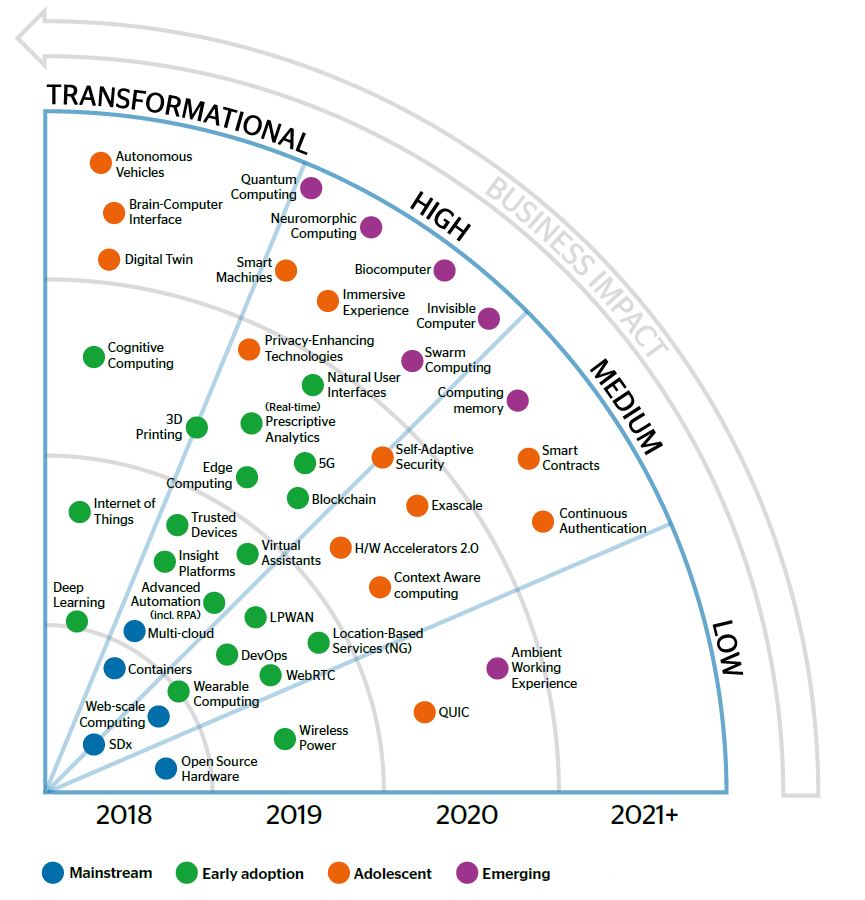
Source: Altos industry and technology experts
Printing the Future in 3D สำหรับภาวะตลาดการพิมพ์สามมิติในระดับโลกนั้นมีมูลค่าอยู่ที่ 4.16 พันล้านเหรีญสหรัฐในปี 2014 และพยากรณ์ว่าจะมีมูลค่าถึง 44.39 พันล้านเหรียญสหรัฐ ในปี 2025 ด้วย CAGR ที่ 21.8% ระหว่างปี 2019 ถึง 2025 ภูมิภาคอเมริกาเหนือครองส่วนแบ่งการตลาดการพิมพ์สามมิติในโลกถึง 1.73 พันล้านเหรียญสหรัฐในปี 2014 และพยากรณ์ว่าจะมีมูลค่าสูงถึง 16.84 พันล้านเหรียญสหรัฐ ในปี 2025 ด้วย CAGR ที่ 20.8% ในช่วงเวลาเดียวกัน ทศวรรษแห่งนวัตกรรมที่ผ่านมาผลักดันให้เกิดวิวัฒนาการของระบบการพิมพ์สามมิติ การปรับปรุงด้านความเร็ว เทคโนโลยีการพิมพ์ และวัตถุดิบในการพิมพ์สามมิติได้มาบรรจบกันอย่างลงตัวและขับเคลื่อนให้ทั้งภาคอุตสาหกรรมก้าวไปข้างหน้า อีกทั้ง การแข่งขันและการลงทุนในอุตสาหกรรมการพิมพ์สามมิติ ภาวะต่างๆ เหล่านี้มีส่วนสำคัญในการกำหนดทิศทางการผลิตชิ้นงานประเภทงานต้นแบบ อย่างไรก็ดีจุดเปลี่ยนของอุตสาหกรรมการพิมพ์สามมิติกำลังจะมาถึง

Source: Allied Market Research

Source: ARK Investment Management LLC
Global 5 G โดยที่ตลาด 5G ของโลกได้รับความสนใจนั้น เนื่องมาจากจำนวนการจดทะเบียนเครือข่ายบอร์ดแบนที่คาดว่าจะพุ่งสูงขึ้นถึง 1.5 พันล้านหน่วยภายในปี 2024 ซึ่งมีจำนวนมากกว่าประชากรโลกถึง 40 เปอร์เซ็นต์ตามรายงานของ Ericsson Mobility และด้วยตัวเลขนี้เองที่ทำให้ระบบ 5G ที่เร็วและแรงที่สุดในขณะนี้ได้มีพื้นที่บนเวทีตลาดโลก และมีแนวโน้มว่าความขับคั่งของสัญญาณเครือข่ายโทรศัพท์เคลื่อนที่จะเพิ่มขึ้นเก็น 5 เท่านับตั้งแต่ปี 2018 จนถึง 2024 ซึ่งกลไกสำคัญที่จะผลักดันให้ 5G เป็นที่ยอมรับก็คือสมรรถภาพของเครือข่ายและอัตราค่าบริการสัญญาณสื่อสารที่ถูกลง
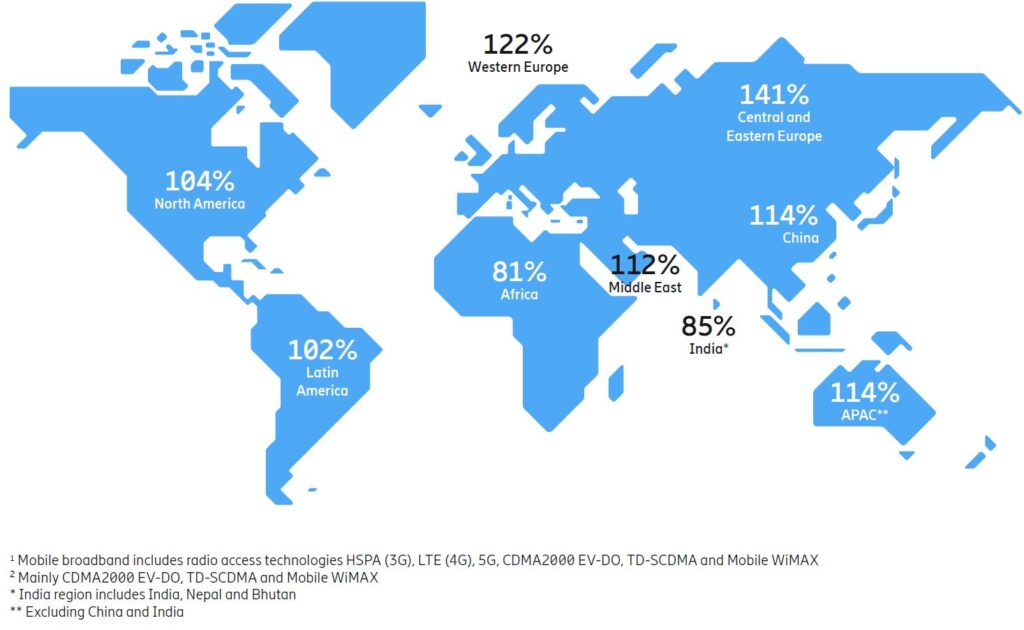
Source: Ericsson Mobility Report
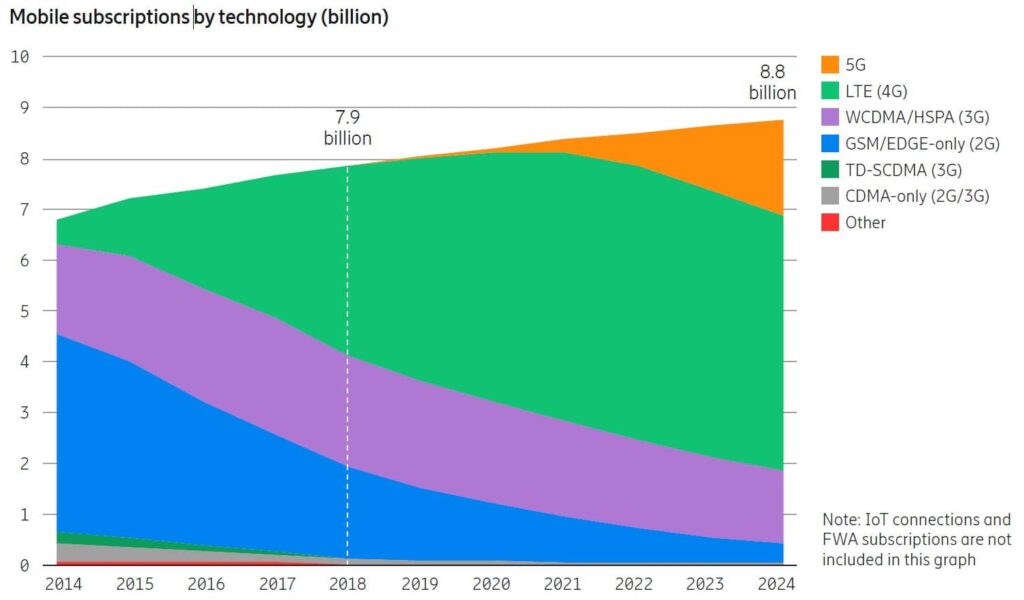
Source: Ericsson Mobility Report
คาดการณ์ว่าอัตราเร็วการขึ้นทะเบียนอุปกรณ์สื่อสาร 5G อยู่ในภาวะขาขึ้นและจะเร็วกว่า LTE ซึ่งยังครองแชมป์อยู่ในปัจจุบัน ในเวทีระดับโลกนั้นการเตรียมความพร้อมเพื่อรองรับเครือข่ายสัญญาณ 5G คาดว่าจะสามารถเริ่มดำเนินจนแล้วเสร็จกินเวลานับตั้งแต่ปี 2020 และจะแล้วเสร็จในปี 2024 โดยคาดการณ์ว่าจำนวนการจดทะเบียนอุปกรณ์สัญญาณสื่อสาร 5G จะอยู่ที่ 1.5 พันล้านอุปกรณ์ ซึ่งจะคิดเป็น 17 เปอร์เซ็นต์ของจำนวนการจดทะเบียนอุปกรณ์สัญญาณสื่อสารที่เคยมีมาในโลก ในระหว่างปี 2018 ถึง 2024 ความหนาแน่นของสัญญาณจากอุปกรณ์สื่อสารจะสูงขึ้นเป็นจำนวน 5 เท่า โดยที่ 25 เปอร์เซ็นต์ในจำนวนดังกล่าวจะมาจากอุปกรณ์สื่อสารที่ใช้ช่องสัญญาณ 5G ภายในช่วงเวลาเดียวกัน
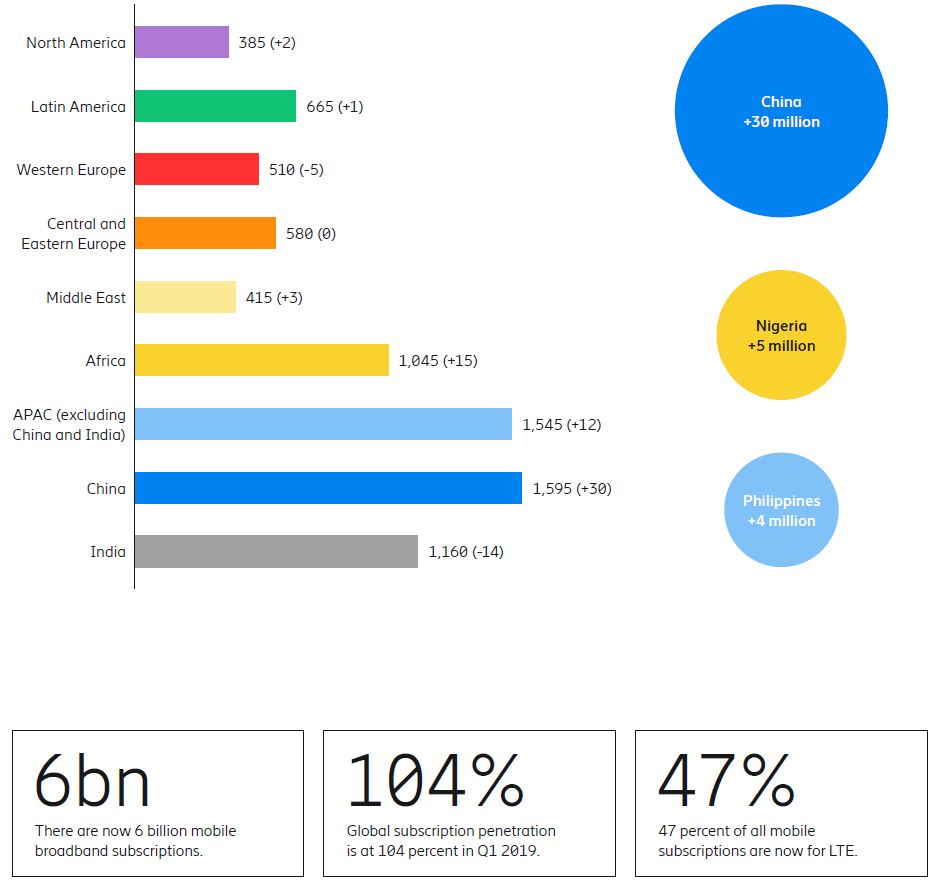
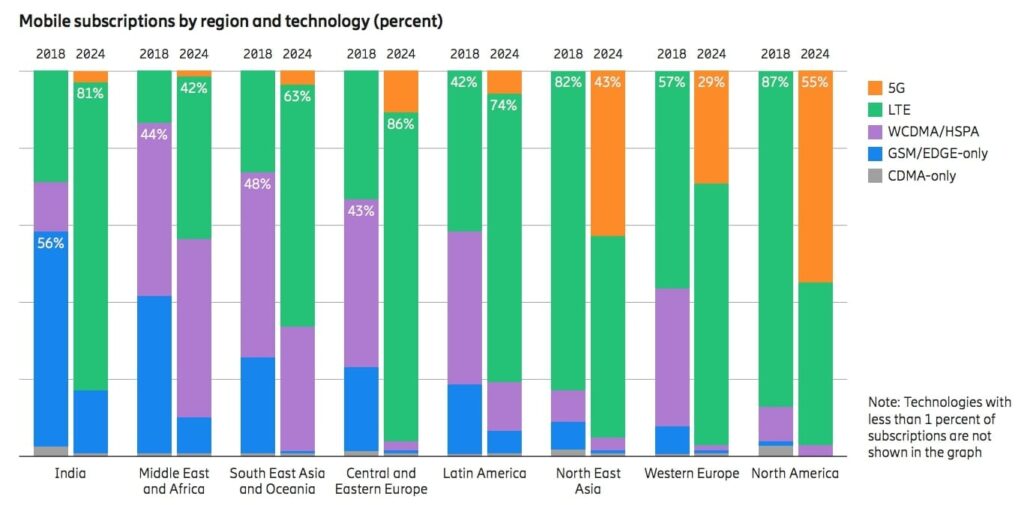
Source: Ericsson Mobility Report
Blockchain for Manufacturing
บล็อกเชนเปรียบได้กับระบบบัญชีแบบรวมศูนย์ที่เก็บรวบรวมธุรกรรมทั้งหมดในเครือข่ายเอาไว้ ผู้ที่เข้าร่วมในเครือข่ายที่ใช้เทคโนโลยีบล็อกเชนสามารถที่จะยืนยันธุรกรรมได้โดยที่ไม่จำเป็นต้องพึ่งพาหน่วยงานหรือบุคคลที่สามเพื่อประโยชน์ในการรับรองยืนยันความถูกต้อง บิตคอยน์หรือผลิตภัณฑ์ที่เกิดจากการประยุกต์ใช้เทคโนโลยีบล็อกเชนต่างได้รับความสนใจเป็นข่าวในสื่อ แต่บริษัทในภาคอุตสาหกรรมการผลิตต่างก็พยายามผลักดันให้เกิดนวัตกรรมจนเป็นสินค้าที่มีมูลค่าการซื้อขายในตลาดได้จริง บริษัทในภาคอุตสาหกรรมการผลิตเหล่านี้ต่างพัฒนาและทดลองประยุกต์ใช้เทคโนโลยีบล็อกเชนที่จะเป็นต้นแบบของการสื่อสารในระดับองค์กรกับองค์กรในอนาคต
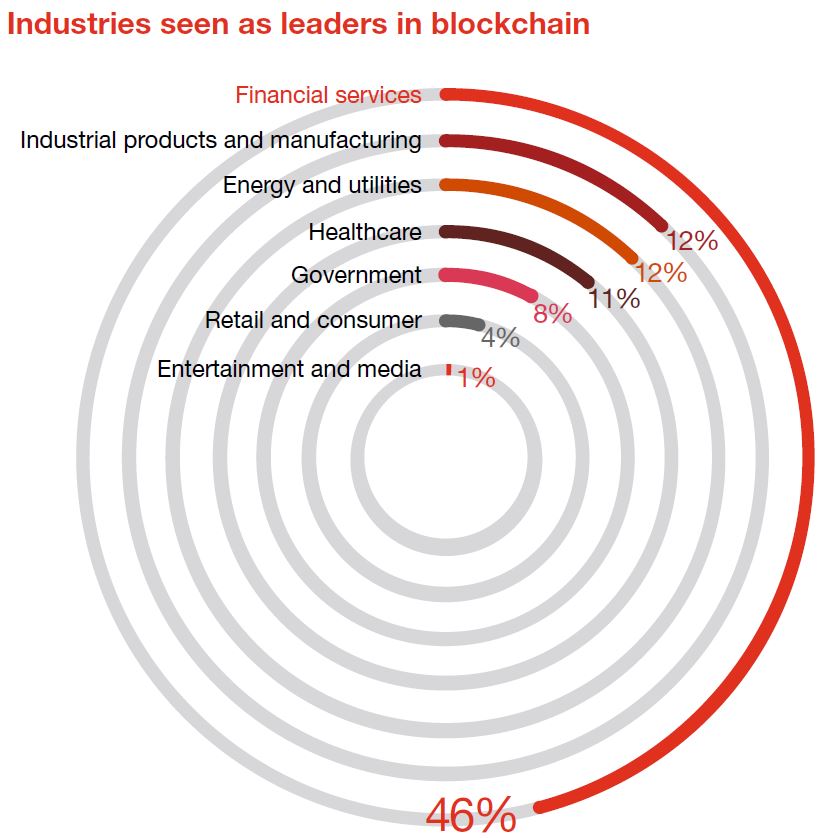
Source: Blockchain in manufacturing, PWC
ศักยภาพของเทคโนโลยีบล็อกเชนที่นำมาใช้ในงานโลจิสติกส์และห่วงโซ่อุปทานต่างเป็นที่ยอมรับในหลากหลายอุตสาหกรรม บทวิเคราะห์จาก Capgemini ได้กล่าวถึงบล็อกเชนว่าจะเกิดกระแสของเทคโนโลยีอยู่ 3 ระลอก โดยที่ระลอกแรกเกิดขึ้นในปี 2011 จนถึงปี 2018 บริษัทห้างร้านต่างลงทุนไปกับการทำเข้าความใจเทคโนโลยี ผลพวงที่เกิดจากการนำเทคโนโลยีไปประยุกต์ใช้ การสร้างความตระหนักในผลกระทบจากเทคโนโลยี ระลอกที่สองเกิดขึ้นในปี 2017 จนถึงปี 2020 ในระลอกนี้ บริษัทห้างร้านต่างสำรวจและทดสอบแนวคิดที่จะนำตัวเทคโนโลยีมาใช้งาน และจะมีการจัดตั้งองค์กรสมาพันธ์ทางการค้าเพื่อความร่วมมือ และระลอกที่สามเกิดขึ้นในปี 2019 จนถึงปี 2025 เป็นช่วงเวลาที่บริษัทห้างร้านเข้าสู่กระบวนการแปรงรูปองค์กร การบูรณาการองค์กร และสถาปนานโยบายความเป็นส่วนตัวและการบริหารจัดการข้อมูลสารสนเทศ
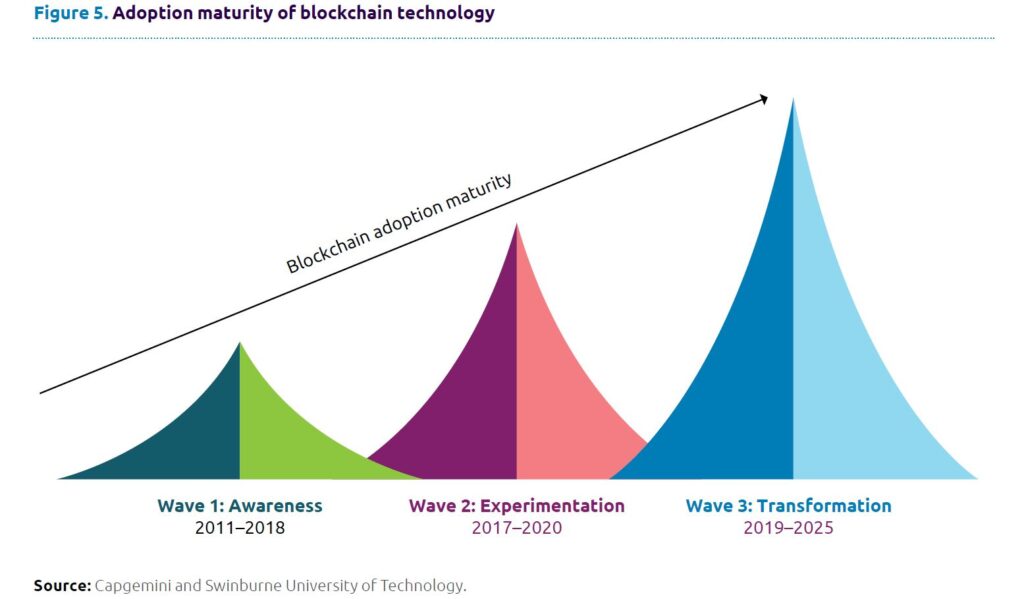
Source: Capgemini and Swinburne University of Technology
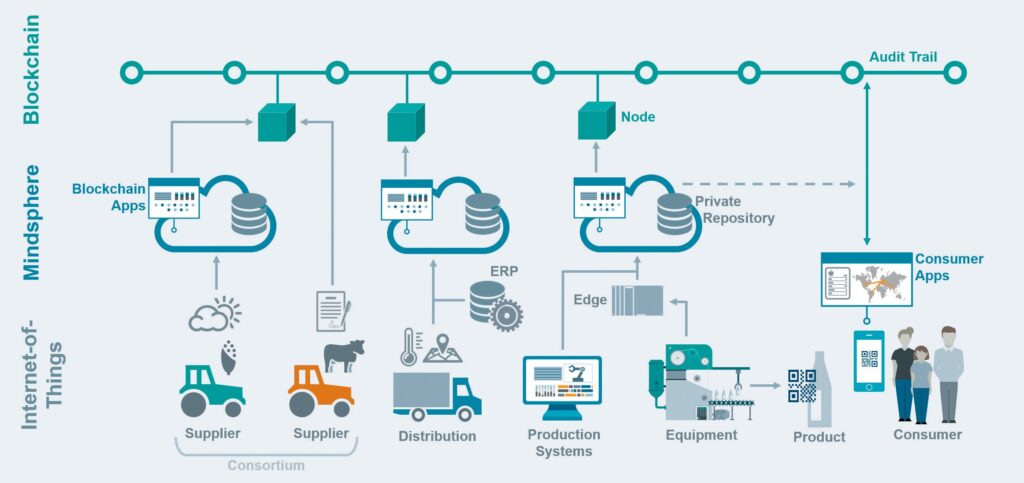
Source: Siemens
Take-Home Message
ในบรรดาเทคโนโลยีทั้ง 3 ที่ได้กล่าวมานี้ เทคโนโลยีบล็อกเชนมีความโดนเด่นที่สุดที่จะนำไปใช้ในการรับมือกับปัญหาเรื้อรังที่ลดทอนประสิทธิภาพในกระบวนการห่วงโซ่อุปทานอย่างเช่นปัญหาการติดตามพัสดุหรือสินค้า ห่วงโซ่อุปทานนับวันก็จะยิ่งทวีความซับซ้อนขึ้น อย่างไรก็ดี ความสามารถในการติดตาม ความสามารถในการรับมือกับสถานการณ์ และความเชื่อมั่น ก็นับเป็นอุปสรรคที่ขัดขวาง ไม่นำพาให้เกิดความคล่องตัวและประสิทธิภาพของเครือข่ายห่วงโซ่อุปทาน ก่อนอื่นที่จะนำเทคโนโลยีบล็อกเชนมาใช้งาน องค์กรจะต้องเข้าใจสภาพองค์กรรวมถึงจุดบกพร่องที่ควรได้รับการแก้ไข ประเมินอย่างตรงไปตรงมาบล็อกเชนใช่คำตอบที่ดีที่สุดแล้วหรือไม่ และสามารถระบุชี้ชัดได้ว่าควรจะเริ่มต้น ณ จุดใด อย่างไร เพื่อทดสอบพิสูจน์แนวคิด ก่อนที่จะเกิดการดำเนินการจริงแบบเต็มรูปแบบ
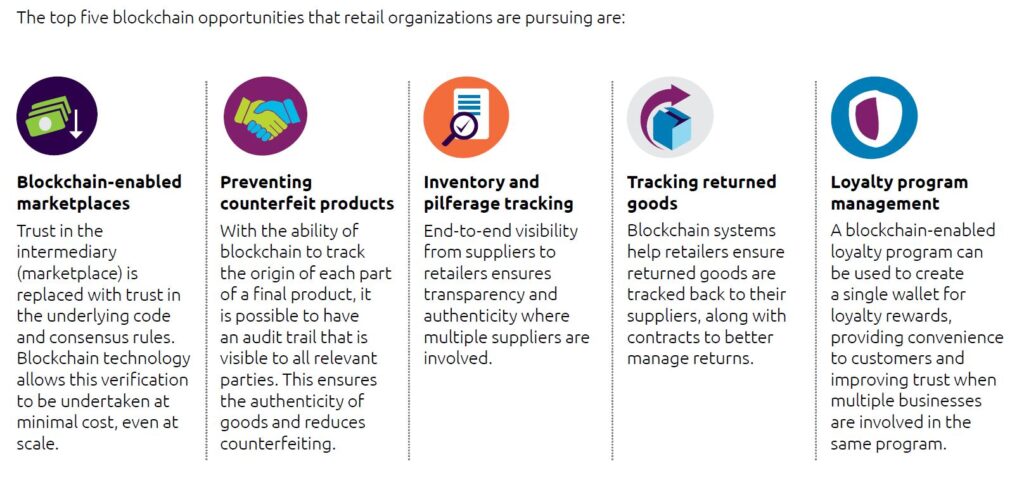
Source: Capgemini and Swinburne University of Technology












